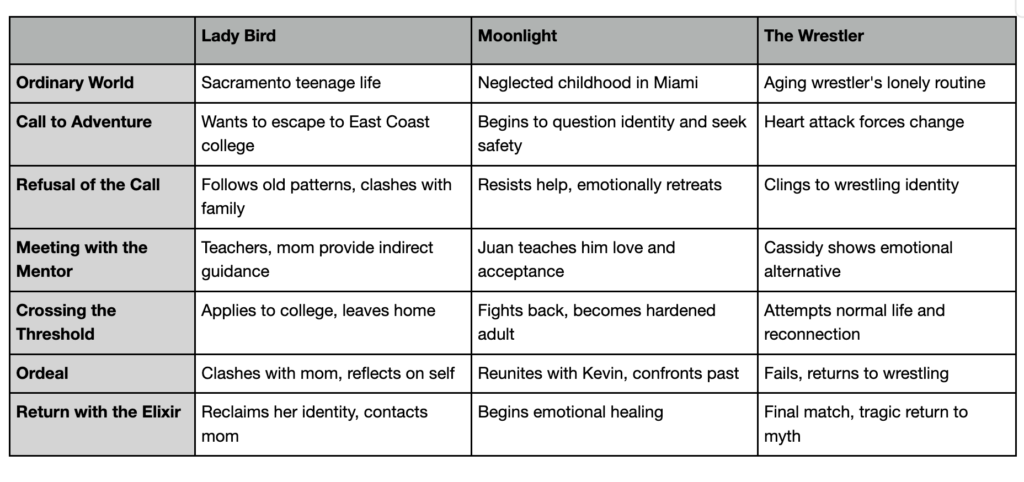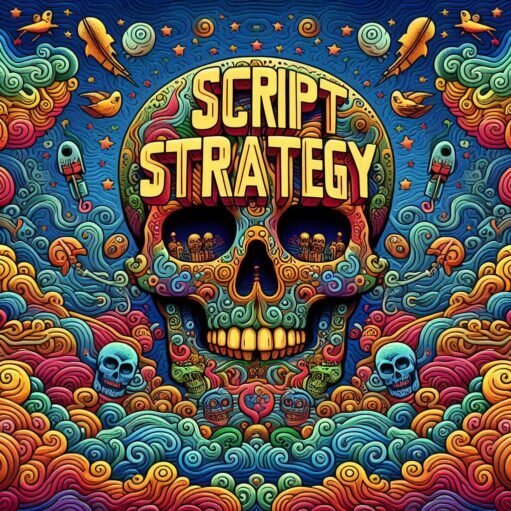How an Independent Movie Might Use the Hero’s Journey as a Template

Sprawling narratives such as Star Wars, The Matrix, or The Lord of the Rings track a protagonist as they leave the comfort of the familiar, venture into unknown territory, undergo trials, and return transformed.
Nevertheless, the Hero’s Journey isn’t reserved only for studio tentpoles. In fact, independent films often use the Hero’s Journey in inventive, intimate ways that ground in everyday emotion what could otherwise be read as an epic story arc.
With that in mind, let’s look at how an independent filmmaker can use the Hero’s Journey as a template. Particularly, what that film looks like when its story doesn’t involve saving the galaxy, wielding swords, or fighting monsters.
First, let’s start with a quick overview.
The Hero’s Journey: A Quick Refresher
The Hero’s Journey was first popularized by Joseph Campbell in The Hero with a Thousand Faces and adapted specifically for screenwriters by Christopher Vogler in The Writer’s Journey. Here are the Hero’s Journey’s key narrative beats:
- Ordinary World
- Call to Adventure
- Refusal of the Call
- Meeting with the Mentor
- Crossing the First Threshold
- Tests, Allies, and Enemies
- Approach to the Inmost Cave
- Ordeal
- Reward (Seizing the Sword)
- The Road Back
- Resurrection
- Return with the Elixir
This pattern, while traditionally epic, translates well to internal journeys, particularly in independent cinema where budgetary constraints demand a more character-driven approach to story.
Reframing the “Hero” in Indie Film
In indie movies, the “hero” doesn’t have to be a chosen one or a warrior. They can be:
- A shy teen confronting first love (Lady Bird)
- A woman processing grief in isolation (Nomadland)
- A man seeking connection after trauma (Manchester by the Sea)
The stakes may be personal rather than cosmic, but the emotional arc follows the same trajectory. In each of these cases, the Hero begins in a status quo she cannot maintain, faces disruptions, meets challenges, and eventually returns changed.
How Indie Films Map Onto the Hero’s Journey
Let’s walk through how each stage of the Hero’s Journey might manifest in a small-scale, emotionally rich indie film.
1. Ordinary World
We meet the protagonist in a stifling routine or stagnant emotional state. For example, in Frances Ha, Frances is a struggling dancer clinging to her old life in New York despite everything shifting around her.
2. Call to Adventure
Something disrupts the protagonist’s status quo: a breakup, getting fired, a diagnosis, or a letter from the past. In Short Term 12, Grace faces new emotional challenges when a young girl arrives at the youth facility where she works.
3. Refusal of the Call
The protagonist hesitates. Change is scary. This might appear as avoidance, substance use, denial, or lashing out. Many indie film protagonists are passive early on, unsure how or whether to change.
4. Meeting the Mentor
The mentor could be an actual person (a wise therapist or teacher), metaphorical (a triggering event), or even spiritual (a memory or internal voice). In The Florida Project, Moonee doesn’t have a mentor in the classic sense, but moments of clarity and kindness shift her understanding of her world.
5. Crossing the Threshold
The character leaves her comfort zone. She takes a risk, says yes to a new job, moves out, or confronts someone. This moment doesn’t have to be melodramatic, but it does need to be definitive.
6. Tests, Allies, and Enemies
Now in unfamiliar territory, the protagonist faces interpersonal and internal tests. She may clash with friends or encounter new perspectives. In Little Miss Sunshine, the family encounters all sorts of hurdles–comic and tragic–on their road trip.
7. Approach to the Inmost Cave
The emotional heart of the story: the protagonist confronts the thing she fears most: abandonment, failure, truth. In Room, this is when Joy and Jack attempt to escape and must deal with the trauma of reintegration.
8. Ordeal
The moment of deepest crisis. The character is broken or must sacrifice something. In The Rider, Brady accepts that his days as a rodeo star are over.
9. Reward
The insight gained from surviving the ordeal. It could be closure, love, or self-acceptance. It’s often quiet and internal.
10. The Road Back
She begins her return to the world, changed. Maybe they write the letter they avoided, call their father, or move back home. In Garden State, Andrew goes back to say goodbye to his old patterns.
11. Resurrection
The final emotional transformation. The protagonist proves she has grown. She acts with clarity or courage, making a new choice.
12. Return with the Elixir
The protagonist carries her hard-won insight into the world. The ending may not be a resounding triumph, but the audience experiences some sense of hope, honesty, or resolution. In The Station Agent, Fin reconnects with others after a long period of solitude.
Why the Hero’s Journey Works for Indie Film
Even stripped of spectacle, the Hero’s Journey provides structure, purpose, and rhythm. Here’s why it works so well for indie storytelling:
1. Emotional Clarity
The journey framework helps track inner change. A character study often seems meandering without significant emotional signposts.
2. Audience Engagement
We instinctively recognize the Hero’s Journey. Campbell might argue that the story is innate and unconscious. I doubt that, but one thing that’s for sure is that it’s familiar to us from extreme exposure. Even when the Hero’s Journey is subtle, viewers feel the tension and release, the arc from who the character was to who they become.
3. Budget-Friendly Narrative
Because the Hero’s Journey centers on transformation, it doesn’t require big set pieces. A single apartment, a road trip, or a small town can be the setting for substantial emotional evolution.
Three Examples of the Hero’s Journey in Independent Cinema
Here are three character-driven independent films that effectively use elements of the Hero’s Journey, even if they adapt or subvert the traditional structure:
1. Lady Bird (2017, dir. Greta Gerwig)
Hero: Christine “Lady Bird” McPherson
Ordinary World: Sacramento, California, 2002 — Lady Bird lives with her working-class family and attends Catholic school.
Call to Adventure: Lady Bird longs to escape her hometown and attend an East Coast college, rejecting her mother’s vision for her life.
Refusal of the Call: She initially follows familiar patterns — rebelling aimlessly, dating the wrong guys, and clashing with authority.
Meeting with the Mentor: Multiple figures, including her teacher Sister Sarah Joan and even her mother, offer guidance — often indirectly.
Crossing the Threshold: Lady Bird applies to colleges in secret and eventually gets accepted to a school in New York.
Ordeal: After a falling out with her mother and moments of self-doubt, she confronts the consequences of her actions and the truth of her upbringing.
Return with the Elixir: In New York, she adopts her given name, Christine, and reaches out to her mother — symbolizing maturity and self-acceptance.
Lady Bird focuses on internal change over external adventure. Lady Bird’s transformation is emotional and relational — a hallmark of a well-executed indie take on the Hero’s Journey.
2. Moonlight (2016, dir. Barry Jenkins)
Hero: Chiron (a.k.a. Little / Chiron / Black)
Ordinary World: A neglected child in a tough Miami neighborhood.
Call to Adventure: His identity and vulnerability draw attention — first from bullies and later from a surrogate father figure, Juan.
Refusal of the Call: Chiron struggles to open up and accept help or love, shielding himself from the pain around him.
Meeting with the Mentor: Juan provides emotional shelter and helps Chiron begin to understand his sexuality.
Crossing the Threshold: After being betrayed and physically assaulted, teenage Chiron violently retaliates — a turning point.
Ordeal: As an adult, Chiron lives behind a hardened persona (“Black”), emotionally walled off from others.
Return with the Elixir: A reunion with Kevin allows Chiron to begin confronting his true self and experiencing vulnerability again.
Moonlight stretches the Hero’s Journey over three acts of a life, using minimal dialogue and rich symbolism. The journey is psychological — a fight for identity, love, and self-worth.
3. The Wrestler (2008, dir. Darren Aronofsky)
Hero: Randy “The Ram” Robinson
Ordinary World: A washed-up professional wrestler barely scraping by in New Jersey.
Call to Adventure: A heart attack forces Randy to reconsider his career and reconnect with his estranged daughter.
Refusal of the Call: He clings to his wrestling identity, resisting the vulnerability required to change his life.
Meeting with the Mentor: Cassidy, a stripper with her own dreams and limitations, serves as a mirror and guide.
Crossing the Threshold: Randy attempts to embrace a new path — working retail and trying to make amends with his daughter.
Ordeal: He fails — driven by self-destructive habits, loneliness, and a desperate need for audience validation.
Return with the Elixir: He returns to the ring for one final match, choosing his mythic identity over an uncertain new life.The Wrestler subverts the traditional heroic return. The “elixir” is tragic and ambiguous — a return to what he knows, even at the risk of his own death.
A Check, Not a Template
Each of these emotionally resonant films maps tidily onto the Hero’s Journey. That doesn’t mean that they were written with the Hero’s Journey front of mind.
However, as we can see, the journey structure could easily take otherwise forgettable aspects of each film and make them emotionally resonant.
Remember that structures such as the Hero’s Journey are invaluable as editing tools, but often produce stilted scripts when you try to use them as a paint-by-numbers writing system. Write from the heart, but fine-tune with systems such as the Hero’s Journey.
